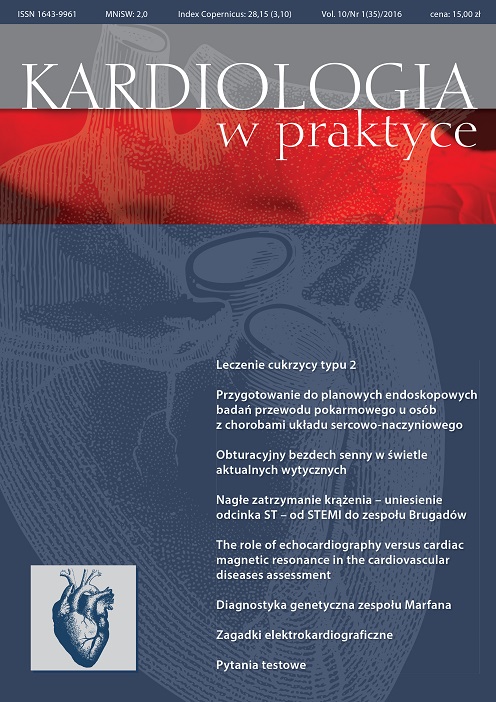Genetic testing in Marfan syndrome Review article
Main Article Content
Abstract
Marfan syndrome is one of the most common genetic disorders of connective tissue and is inherited in an autosomal dominant manner. Marfan syndrome is mainly caused by mutations in the FBN1 gene encoding fibrillin-1, which leads to excess of transforming growth factor-β. Affected individuals have an increased risk of aortic root dilatation as well as aortic dissection, which is the main cause of sudden death. Prevention of these cardiovascular complications requires early and accurate diagnosis, which is difficult because clinical characteristics of Marfan syndrome is similar to a variety of other hereditary disorders from which it should be distinguished. In the revised Ghent criteria, Marfan syndrome is diagnosed on the basis of a set of clinical symptoms and genetic testing.
Downloads
Article Details

This work is licensed under a Creative Commons Attribution-NonCommercial-NoDerivatives 4.0 International License.
Copyright: © Medical Education sp. z o.o. This is an Open Access article distributed under the terms of the Attribution-NonCommercial 4.0 International (CC BY-NC 4.0). License (https://creativecommons.org/licenses/by-nc/4.0/), allowing third parties to copy and redistribute the material in any medium or format and to remix, transform, and build upon the material, provided the original work is properly cited and states its license.
Address reprint requests to: Medical Education, Marcin Kuźma (marcin.kuzma@mededu.pl)
References
2. Dietz H.C., Cutting G.R., Pyeritz R.E. et al.: Marfan syndrome caused by a recurrent de novo missense mutation in the fibrillin gene. Nature 1991; 352(6333): 337-379.
3. Sakai L.Y., Keene D.R., Engvall E.: Fibrillin, a new 350-kD glycoprotein, is a component of extracellular microfibrils. J. Cell. Biol. 1986; 103(6 Pt 1): 2499-2509.
4. Detaint D., Faivre L., Collod-Beroud G. et al.: Cardiovascular manifestations in men and women carrying a FBN1 mutation. Eur. Heart J. 2010; 31(18): 2223-2229.
5. Aalberts J.J., van Tintelen J.P., Meijboom L.J. et al.: Relation between genotype and left-ventricular dilatation in patients with Marfan syndrome. Gene 2014; 534(1): 40-43.
6. von Kodolitsch Y., De Backer J., Schuler H. et al.: Perspectives on the revised Ghent criteria for the diagnosis of Marfan syndrome. Appl. Clin. Gen. 2015; 8: 137-155.
7. Hiratzka L.F., Bakris G.L., Beckman J.A. et al.: 2010 ACCF/AHA/AATS/ACR/ASA/SCA/SCAI/SIR/STS/SVM guidelines for the diagnosis and management of patients with Thoracic Aortic Disease: a report of the American College of Cardiology Foundation/American Heart Association Task Force on Practice Guidelines, American Association for Thoracic Surgery, American College of Radiology, American Stroke Association, Society of Cardiovascular Anesthesiologists, Society for Cardiovascular Angiography and Interventions, Society of Interventional Radiology, Society of Thoracic Surgeons, and Society for Vascular Medicine. Circulation 2010; 121(13): e266-e369.
8. Radke R.M., Baumgartner H.: Diagnosis and treatment of Marfan syndrome: an update. Heart 2014; 100(17): 1382-1391.
9. Hilhorst-Hofstee Y., Rijlaarsdam M.E., Scholte A.J. et al.: The clinical spectrum of missense mutations of the first aspartic acid of cbEGF-like domains in fibrillin-1 including a recessive family. Hum. Mutat. 2010; 31(12): E1915-E1927.
10. Gillis E., Kempers M., Salemink S. et al.: An FBN1 deep intronic mutation in a familial case of Marfan syndrome: an explanation for genetically unsolved cases? Hum. Mutat. 2014; 35(5): 571-574.
11. Collod G., Babron M.C., Jondeau G. et al.: A second locus for Marfan syndrome maps to chromosome 3p24.2-p25. Nat. Genet. 1994; 8(3): 264-268.
12. Mizuguchi T., Collod-Beroud G., Akiyama T. et al.: Heterozygous TGFBR2 mutations in Marfan syndrome. Nat. Genet. 2004; 36(8): 855-860.
13. Byers P.H.: Determination of the molecular basis of Marfan syndrome: a growth industry. J. Clin. Invest. 2004; 114(2): 161-163.
14. Neptune E.R., Frischmeyer P.A., Arking D.E. et al.: Dysregulation of TGF-beta activation contributes to pathogenesis in Marfan syndrome. Nat. Genet. 2003; 33(3): 407-411.
15. Loeys B.L., Dietz H.C., Braverman A.C. et al.: The revised Ghent nosology for the Marfan syndrome. J. Med. Genet. 2010; 47(7): 476-485.
16. Maher J.W., Hollenbeck J.I., Sierakowski N. et al.: Effects of biocarbonate perfusion on lower esophageal sphincter response to feeding. Surg. Forum 1975; 26: 366-368.
17. Sheikhzadeh S., Kade C., Keyser B. et al.: Analysis of phenotype and genotype information for the diagnosis of Marfan syndrome. Clin. Genet. 2012; 82(3): 240-247.

